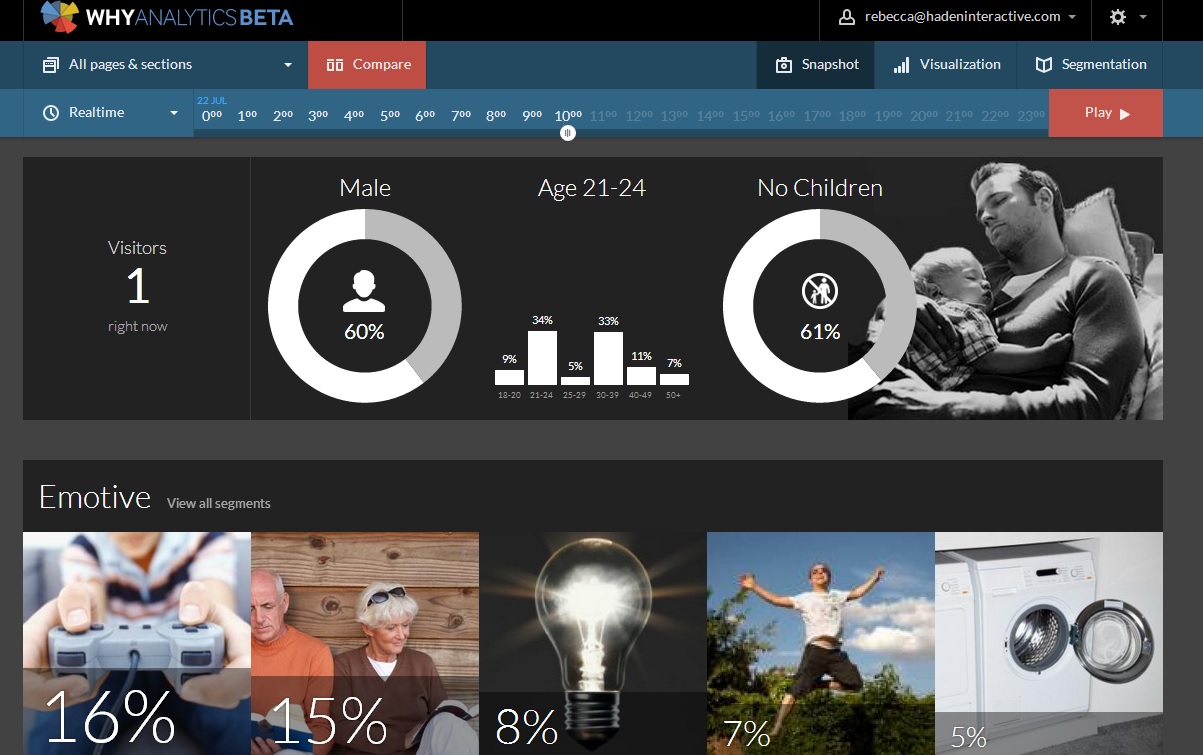Your cart is currently empty!

WHYAnalytics from Visual DNA
Google Analytics is our go-to here at Haden Interactive. We’ve run into an interesting new analytics tool, though, which does quite different things from GA.
WhyAnalytics doesn’t tell you how many visitors you’ve had with anything like accuracy, and it doesn’t tell you where your visitors come from or what they do at your website. It tells you who your visitors are.
The screenshot here shows a real-time result: there was one visitor at our website at the particular moment captured here, and he was a young guy with no kids. Or so WhyAnalytics thinks.
We also use Sprout Social for our social media analytics, and Sprout tells us whether our visitors are male or female, as well as their ages. WhyAnalytics takes it further. As you can see from the screenshot below, it takes a guess at your visitors’ emotions, interests, an buying intentions as well.
How do they know? It’s pretty clever. They use a cookie to follow your visitors after they leave your website. Based on their behavior after leaving, they classify these visitors into a variety of groups. The groups have been determined based on the millions of responses they’ve had to their online personality tests. See a sample question below:
In addition to these questions, there are also a bunch of brand choice questions, like this one about coffee:
The same photo images turn up in the analytics. Based on the millions of people who have taken the test, Visual DNA makes correlations and draws conclusions about your visitors.
WhyAnalytics says the visitors to this website are mostly guys, mostly young and without kids. They’re “Idea Seekers,” smart guys who see loving companionship as the basis of a good relationship, they prefer Apple, and 17% of them are gamers. Slightly more are bookworms.
Rosie thinks they sound like a good dating pool.
This is actually a pretty good picture of our average visitor, as far as we know. If we were selling consumer packaged goods, we might be able to get a good image of our online visitor, which we could then compare with our in-store shoppers. We could use this information to tailor our message — either to fine tune it to best serve our online visitors, or to change it to appeal to the people who are most likely to buy.
This would also be good information for planning campaigns. For example, many products can easily focus either on the pain they solve or the joy they bring. Knowing that your readers are frustrated, downhearted, stress reacters (three of the types included in the WhyAnalytics metrics) would tell you that focusing on the pain would be the way to go.
WhyAnalytics is still in beta testing, but it’s worth checking out. If you try it, please let us know how well its information about your site meshes with your knowledge about your customers. The big question here is of course how accurate these insights might be.
by
Tags:






Leave a Reply